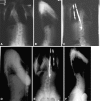The usefulness of VEPTR in the older child with complex spine and chest deformity
- PMID: 19455376
- PMCID: PMC2816761
- DOI: 10.1007/s11999-009-0886-7
The usefulness of VEPTR in the older child with complex spine and chest deformity
Abstract
The vertical expandable prosthetic titanium rib (VEPTR) was originally designed to treat chest and spine deformities in young children. However, older children with complex spinal deformities may also benefit from placement of a VEPTR when vertebral column resections are deemed too risky neurologically. We report: (1) the changes in Cobb angle, T1 angle, and head tilt; and (2) the occurrence of complications in children older than 10 years of age treated with VEPTR. From a database of 214 patients treated in a Food and Drug Administration Investigational Device Exemption study of VEPTR, we identified 10 patients with assorted diagnoses who underwent surgery after age 10 and had a minimum of 24-month followup (mean, 39.6 months; range, 24-75 months). No patient sustained neurologic injury. Patients underwent an average of five lengthenings. The mean preoperative Cobb angle was 64.7 degrees and improved to 48.4 degrees. Head shift improved an average of 3.8 cm. Two device-related complications occurred (both in the same patient). Four patients have since undergone definitive spinal fusion. For a select group of patients 10 years of age or older, the VEPTR offers a reasonable alternative to potentially risky vertebral column resections for correcting deformities in selected patients.
Level of evidence: Level IV, therapeutic study. See Guidelines for Authors for a complete description of levels of evidence.
Figures

References
-
- Campbell RM, Jr, Adcox BM, Smith MD, Simmons JW, III, Cofer BR, Inscore SC, Grohman C. The effect of mid-thoracic VEPTR opening wedge thoracostomy on cervical tilt associated with congenital thoracic scoliosis in patients with thoracic insufficiency syndrome. Spine. 2007;32:2171–2177. doi: 10.1097/BRS.0b013e31814b2d6c. - DOI - PubMed
-
- Campbell RM, Jr, Smith MD, Hell-Vocke AK. Expansion thoracoplasty: the surgical technique of opening-wedge thoracostomy. Surgical technique. J Bone Joint Surg Am. 2004;86:51–64. - PubMed
-
- Campbell RM, Jr, Smith MD, Mayes TC, Mangos JA, Willey-Courand DB, Kose N, Pinero RF, Alder ME, Duong HL, Surber JL. The characteristics of thoracic insufficiency syndrome associated with fused ribs and congenital scoliosis. J Bone Joint Surg Am. 2003;85:399–408. doi: 10.1302/0301-620X.85B3.13429. - DOI - PubMed
-
- Campbell RM, Jr, Smith MD, Mayes TC, Mangos JA, Willey-Courand DB, Kose N, Pinero RF, Alder ME, Duong HL, Surber JL. The effect of opening wedge thoracostomy on thoracic insufficiency syndrome associated with fused ribs and congenital scoliosis. J Bone Joint Surg Am. 2004;86:1659–1674. - PubMed
-
- Emans JB, Caubet JF, Ordonez CL, Lee EY, Ciarlo M. The treatment of spine and chest wall deformities with fused ribs by expansion thoracostomy and insertion of vertical expandable prosthetic titanium rib: growth of thoracic spine and improvement of lung volumes. Spine. 2005;30:S58–S68. doi: 10.1097/01.brs.0000175194.31986.2f. - DOI - PubMed
Publication types
MeSH terms
Substances
LinkOut - more resources
Full Text Sources
Medical
Research Materials

